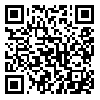Volume 30, Issue 1 (3-2024)
Back to this Issue |
Back to browse issues page
Download citation:
BibTeX | RIS | EndNote | Medlars | ProCite | Reference Manager | RefWorks
Send citation to:



BibTeX | RIS | EndNote | Medlars | ProCite | Reference Manager | RefWorks
Send citation to:
Majidi Sakani S, Amirzadeh Iranagh J, Khalkhali H, Fathi B, Didarloo A. The effect of an educational intervention based on the health belief model on promoting osteoporosis-preventive behaviors in menopausal women: A quasi-experimental study. Journal of Hayat 2024; 30 (1) :93-109
URL: http://hayat.tums.ac.ir/article-1-5170-en.html
URL: http://hayat.tums.ac.ir/article-1-5170-en.html
Salar Majidi Sakani1 

 , Jamileh Amirzadeh Iranagh1
, Jamileh Amirzadeh Iranagh1 

 , Hamidreza Khalkhali2
, Hamidreza Khalkhali2 

 , Behrouz Fathi3
, Behrouz Fathi3 

 , Alireza Didarloo *
, Alireza Didarloo * 

 4
4


 , Jamileh Amirzadeh Iranagh1
, Jamileh Amirzadeh Iranagh1 

 , Hamidreza Khalkhali2
, Hamidreza Khalkhali2 

 , Behrouz Fathi3
, Behrouz Fathi3 

 , Alireza Didarloo *
, Alireza Didarloo * 

 4
4
1- Dept. of Public Health, School of Public Health, Urmia University of Medical Sciences, Urmia, Iran
2- Dept. of Biostatistics and Epidemiology, School of Medicine, Urmia University of Medical Sciences, Urmia, Iran
3- Dept. of Management Sciences and Health Economics, School of Public Health, Urmia University of Medical Sciences, Urmia, Iran
4- Dept. of Public Health, School of Public Health, Urmia University of Medical Sciences, Urmia, Iran ,adidarloo@yahoo.com
2- Dept. of Biostatistics and Epidemiology, School of Medicine, Urmia University of Medical Sciences, Urmia, Iran
3- Dept. of Management Sciences and Health Economics, School of Public Health, Urmia University of Medical Sciences, Urmia, Iran
4- Dept. of Public Health, School of Public Health, Urmia University of Medical Sciences, Urmia, Iran ,
Abstract: (544 Views)
Background & Aim: Osteoporosis is a common problem in menopausal women, and adopting preventive behaviors is crucial in addressing this issue. The purpose of the study is to evaluate the effect of an educational intervention based on the health belief model (HBM) on promoting osteoporosis-preventive behaviors in menopausal women.
Methods & Materials: This quasi-experimental study with a control group was conducted on 64 menopausal women referred to Urmia urban health centers in 2023. Participants were selected using random sampling and then randomly allocated into two groups: control (32) and intervention (32). The data collection instruments included questionnaires comprising demographic information, knowledge assessments, Health Belief Model constructs, food frequency, and physical activity items. Following pre-test evaluations and needs assessment, a training program was designed and delivered to the intervention group. The collected data were analyzed using SPSS software version 26.
Results: The mean scores for knowledge, perceived susceptibility, perceived severity, perceived benefits, perceived self-efficacy, and cues to action in the intervention group significantly increased compared to both the pre-intervention assessment and the control group. Conversely, there was a significant decrease in the mean score for perceived barriers (P<0.05). These changes resulted in a significant increase in the mean score for osteoporosis preventive behaviors within the intervention group (P<0.05).
Conclusion: Education based on the HBM has been effective in shaping the knowledge and health beliefs of menopausal women concerning osteoporosis and its preventive behaviors. Therefore, it is recommended that health educators incorporate the approaches and findings of this study when developing educational interventions related to osteoporosis.
Methods & Materials: This quasi-experimental study with a control group was conducted on 64 menopausal women referred to Urmia urban health centers in 2023. Participants were selected using random sampling and then randomly allocated into two groups: control (32) and intervention (32). The data collection instruments included questionnaires comprising demographic information, knowledge assessments, Health Belief Model constructs, food frequency, and physical activity items. Following pre-test evaluations and needs assessment, a training program was designed and delivered to the intervention group. The collected data were analyzed using SPSS software version 26.
Results: The mean scores for knowledge, perceived susceptibility, perceived severity, perceived benefits, perceived self-efficacy, and cues to action in the intervention group significantly increased compared to both the pre-intervention assessment and the control group. Conversely, there was a significant decrease in the mean score for perceived barriers (P<0.05). These changes resulted in a significant increase in the mean score for osteoporosis preventive behaviors within the intervention group (P<0.05).
Conclusion: Education based on the HBM has been effective in shaping the knowledge and health beliefs of menopausal women concerning osteoporosis and its preventive behaviors. Therefore, it is recommended that health educators incorporate the approaches and findings of this study when developing educational interventions related to osteoporosis.
Send email to the article author
| Rights and permissions | |
 |
This work is licensed under a Creative Commons Attribution-NonCommercial 4.0 International License. |



